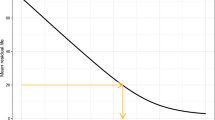Abstract
Purpose
Urinary incontinence (UI) is a chronic, costly condition that impairs quality of life. To identify older women most at risk, the Medical Epidemiologic and Social Aspects of Aging (MESA) datasets were mined to create a set of questions that can reliably predict future UI.
Methods
MESA data were collected during four household interviews at approximately 1 year intervals. Factors associated with becoming incontinent at the second interview (HH2) were identified using logistic regression (construction datasets). Based on p values and odds ratios, eight potential predictive factors with their 256 combinations and corresponding prediction probabilities formed the Continence Index. Its predictive and discriminatory capability was tested against the same cohort’s outcome in the fourth survey (HH4 validation datasets). Sensitivity analysis, area under receiver operating characteristic (ROC) curve, predicted probabilities and confidence intervals were used to statistically validate the Continence Index.
Results
Body mass index, sneezing, post-partum UI, urinary frequency, mild UI, belief of developing UI in the future, difficulty stopping urinary stream and remembering names emerged as the strongest predictors of UI. The confidence intervals for prediction probabilities strongly agreed between construction and validation datasets. Calculated sensitivity, specificity, false-positive and false-negative values revealed that the areas under the ROCs (0.802 and 0.799) for the construction and validation datasets, respectively, indicated good discriminatory capabilities of the index as a predictor.
Conclusion
The Continence Index will help identify older women most at risk of UI in order to apply targeted prevention strategies in women that are most likely to benefit.



Similar content being viewed by others
References
Diokno AC, Brock BM, Brown MB, Herzog AR (1986) Prevalence of urinary incontinence and other urological symptoms in the non-institutionalized elderly. J Urol 136:1022–1025
Diokno AC, Brock BM, Herzog AR, Bromberg J (1990) Medical correlates of urinary incontinence in the elderly. Urology 36:129–138
Herzog AR, Fultz NH, Brock BM, Brown MB, Diokno AC (1988) Urinary incontinence and psychological distress among older adults. Psychol Aging 3:115–121
Diokno AC, Brown MB, Brock BM, Herzog AR, Normolle DP (1988) Clinical and cystometric characteristics of continent and incontinent non-institutionalized elderly. J Urol 140:567–571
Diokno AC, Normolle DP, Brown MB, Herzog AR (1990) Urodynamic tests for female geriatric urinary incontinence. Urology 36:431–439
Herzog AR, Fultz NH, Normolle DP, Brock BM, Diokno AC (1989) Methods used to manage urinary incontinence by older adults in the community. J Am Geriatr Soc 37:339–347
Herzog AR, Diokno AC, Brown MB, Fultz NH, Goldstein NE (1994) Urinary incontinence as a risk factor for mortality. J Am Geriatr Soc 42:264–268
Wells TJ, Diokno AC (1989) Urinary incontinence in the elderly. Semin Neurol 9:60–67
Wells TJ, Brink CA, Diokno AC, Wolfe R, Gillis GL (1991) Pelvic muscle exercise for stress urinary incontinence in elderly women. J Am Geriatr Soc 39:785–791
Sampselle CM, Miller JM, Herzog AR, Diokno AC (1996) Behavioral modification: group teaching outcomes. Urol Nurs 16:59–63
Diokno AC, Sampselle CM, Herzog AR et al (2004) Prevention of urinary incontinence by behavioral modification program: a randomized, controlled trial among older women in the community. J Urol 171:1165–1171
Ogunyemi TO, Siadat MR, Arslanturk S, Killinger KA, Diokno AC (2012) Novel application of statistical methods to identify new urinary incontinence risk factors. Adv Urol, ID 276501, 1–8
Colditz GA, Atwood KA, Emmons K et al (2000) Harvard report on cancer prevention volume 4: Harvard cancer risk index. Cancer Causes Control 11(6):477–488
SAS/STAT User’s Guide, Version 9.3, SAS Institute, Cary, NC, USA 2010
Khullar V, Sexton CC, Thompson CL, Milson I, Bitoun CE, Coyne KS (2014) The relationship between BMI and urinary incontinence subgroups: results from EpiLUTS. Neurourol Urodyn 33:392–399
Jackson RA, Vittinghoff E, Kanaya AM (2004) Urinary incontinence in elderly women: findings from the health aging and body composition study. Obstet Gynecol 104:301–307
Leijonhufvud A, Lundholm C, Cnattingius S, Granath F, Andolf E, Altman D (2011) Risks of stress urinary incontinence and pelvic organ prolapse surgery in relation to mode of childbirth. Am J Obstet Gynecol 204:70.e1–70.e7
Hansen BB, Svare J, Viktrup L, Jorgensen T, Lose G (2012) Urinary incontinence during pregnancy and 1 year after delivery in primiparous women compared with a control group of nulliparous women. Neurourol Urodyn 31:475–480
Morkved S, Bo K (2014) Effect of pelvic floor muscle training during pregnancy and after childbirth on prevention and treatment of urinary incontinence: a systematic review. Br J Sports Med 48:299–310
Offermans MPW, Du Moulin MFMT, Hamer JPH, Dassen T, Halfens RJG (2009) Prevalence of urinary incontinence and associated risk factors in nursing home residents: a systematic review. Neurourol Urodyn 28:288–294
Acknowledgments
The project described was supported by Grant No. R01AG038673 from the National Institutes of Health. The content is solely the responsibility of the authors and does not necessarily represent the official views of the National Institute on Aging or the National Institutes of Health.
Conflict of interest
The authors declare that they have no conflict of interest.
Author information
Authors and Affiliations
Corresponding author
Rights and permissions
About this article
Cite this article
Diokno, A.C., Ogunyemi, T., Siadat, MR. et al. Continence Index: a new screening questionnaire to predict the probability of future incontinence in older women in the community. Int Urol Nephrol 47, 1091–1097 (2015). https://doi.org/10.1007/s11255-015-1006-0
Received:
Accepted:
Published:
Issue Date:
DOI: https://doi.org/10.1007/s11255-015-1006-0




